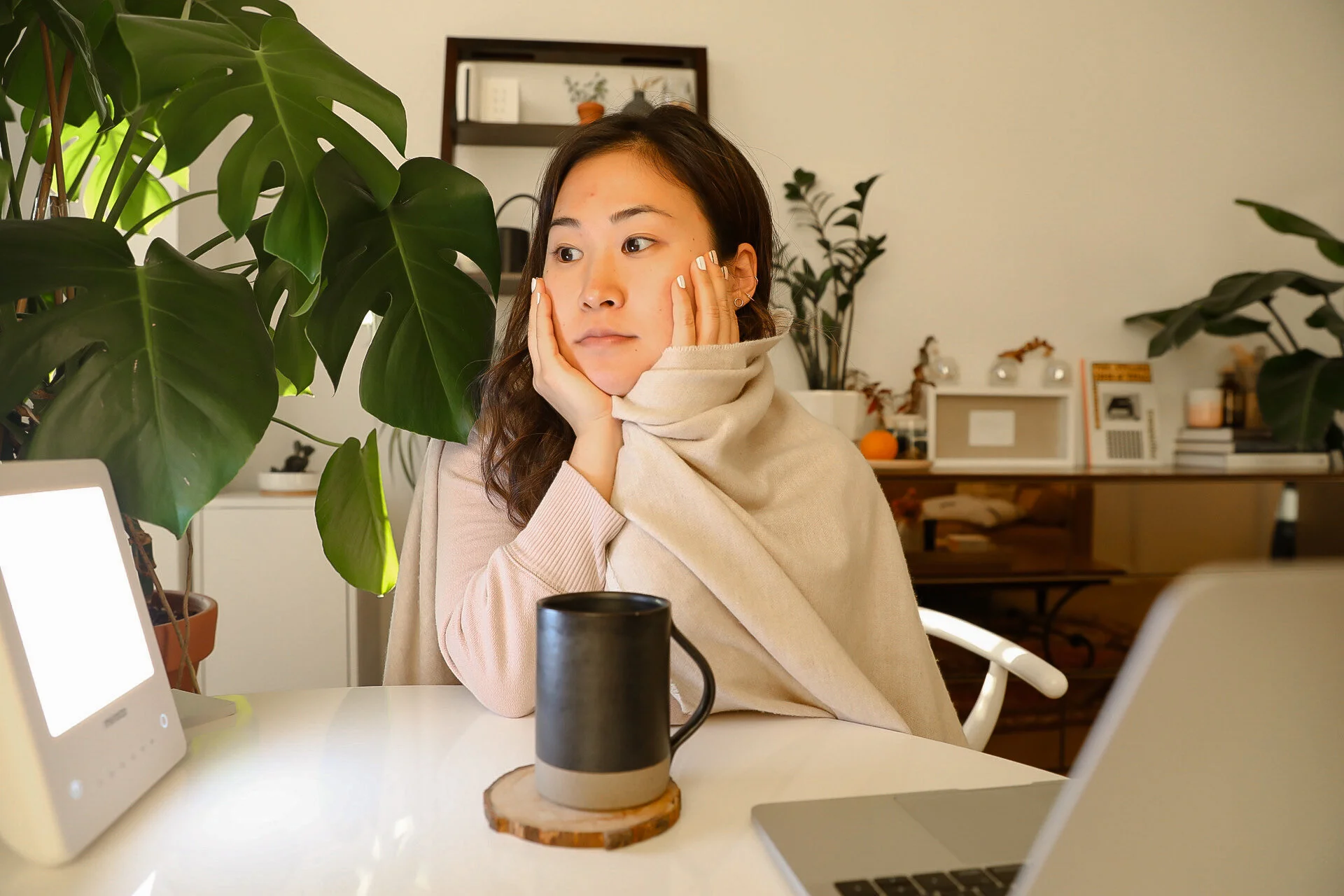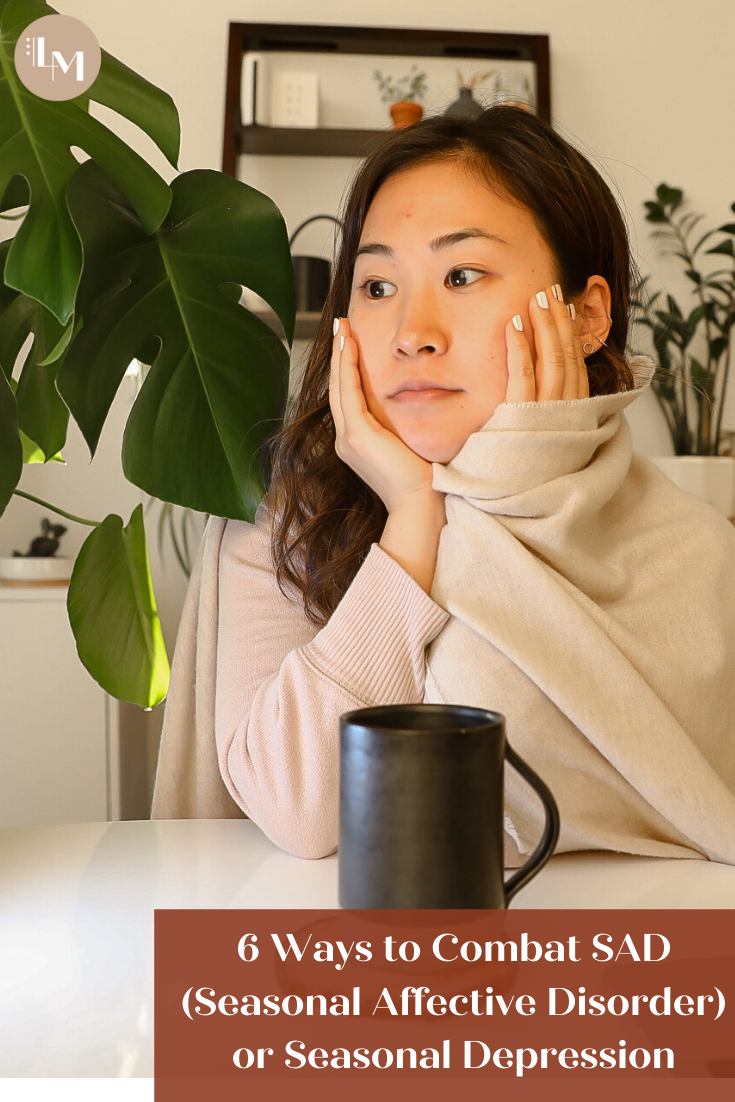6 Ways to Manage Seasonal Affective Disorder (SAD) / Seasonal Depression
6 years ago during December, I was feeling abnormally off. I couldn’t shake the unrelenting feelings of being perpetually exhausted, glum, and was just in a depressive MOOD 24/7— I felt like hibernating all of the time like a sad little winter Eeyore bear. I initially chalked it up to my 5am wake-up times for my training schedule and maybe not getting enough sleep, but then one of my fellow trainers said they always felt this way during wintertime and that I should read up on SAD. My initial response was, “SAD?! Is that actually a real thing? Also, is that acronym even real...” Then I read up on it, a lightbulb went off, and I ran out to purchase a little SAD lamp for light therapy (we’ll get to that more in a minute).
Over the last few years, SAD, otherwise known as Seasonal Affective Disorder, has gained recognition and been the butt of many a meme joke on social media— but one of those jokes that everyone painfully relates to… it me. In reality, only 5% of the population actually has SAD— it’s a biochemical imbalance triggered by the shorter daylight hours during the cold weather months that leads to distressing disruption of daily functioning. BUT, all of the symptoms of SAD (very similar to the symptoms of depression) tends to affect a lot of us to some degree during these winter months when the sun starts to set at freakin’ 3pm (thanks, daylight saving…).
Being a particularly sensitive person, I thankfully (or unthankfully) have a few seasons of dealing with seasonal depression under my belt, so I’ve been able to identify the most effective ways to combat it for me personally. While nothing will completely take away those feelings magically, there ARE a lot of factors we can manage in order to support our brains and bodies during this (literally) dark time in our lives.
DISCLAIMER: I am not a medical professional and this blog post is not meant to diagnose or treat any psychological disorder or disease. If you are experiencing any extreme symptoms, please consult a medical professional for help.
Here are my 6 tips for combatting seasonal affective disorder (SAD) and/or seasonal depression:
1. Exercise consistently— seriously.
This is probably the most immediately effective tip on this list. You all likely know the general benefits of consistent exercise in your life, but the physiological benefits are especially relevant to seasonal depression.
Getting your sweat on for at least 20-30 minutes a day doesn’t just give you the immediate endorphins that make you happy— it also affects the parts of your brain that regulate stress and anxiety by increasing your brain’s sensitivity to serotonin + norepinephrine (hormones that relieve the feelings of depression). Fatigue also tends to be a large part of seasonal depression, so I know it feels THAT much harder to get your booty moving, but exercising will reward you with extra energy— you know that saying, you gotta spend money to make money? Same for energy here. Lastly, consistent exercise is KEY for your endocrine system’s regulation, aka the system that is responsible for your hormonal balance (mood, appetite, mental focus, etc) and metabolic system (energy).
Go for that long walk, dance it out, get your yoga on, or just workout on a mat at home— you don’t have to go to the gym to get these benefits.
2. Manage your circadian rhythm
Your circadian rhythm is a daily cycle that is responsible for your feelings of “awakeness” and sleepiness. It tends to get a little thrown off by winter’s lack of sunlight, because exposure to light is one of the things it relies on to regulate itself, so you may feel sleepy at odd times, groggy in the morning, or unable to fall asleep easily when it’s out of whack.
All the other tips on this list can help regulate your circadian rhythm (particularly the exposure to light tip below), but something I find really helpful is to reinforce “awakeness” when I should be up and at ‘em during what would be normal daylight hours— by this, I mean going outside and getting some sunlight before 9/10am or a light lamp during the morning / early afternoon hours. Going on a morning walk to really breathe in my surroundings (where you are NOT looking at a cell phone screen) and be present has been a huge help to reinvigorate my mind for the rest of the day.
3. Manage your exposure to light: SAD lamps + say NO to blue light
Okay, time to talk about the infamous SAD lamp. The reason for its existence is to light therapy— basically expose you to a little extra light that your body is used to getting during the non-winter time, to simulate sunshine and a normal day of daylight on those gloomy winter days where the sun goes down like 3 hours early. How I tend to use my light is set it to the side of my working space (so it shines on the side of my face— never be looking in the direction of the light, for your eyes’ sake) and run it in intervals. Everyone likes different lengths of time and you should start in intervals of 10 min on then off, but I now use it in intervals of 40 min on then 40 min off. If you are looking to purchase a SAD lamp, I highly recommend finding one that is UV-free and a minimum of 10000 Lux Brightness (what is the recommendation for light therapy). I’ve used a bunch of different ones over the years but I really love the one I have now (linked here) because it’s all of those things, super lightweight and portable, adjustable between 3 brightnesses, and it has an automatic timer to switch off.
Now, as for blue light exposure— too much screentime on your laptop and cell phones can disrupt a lot of things, namely sleep— which is so important for mood regulation, energy, and your well being. A lot of people have issues with quality sleep and falling asleep properly during the wintertime when you’re struggling with seasonal depression / SAD, and it’s important to cut out the blue light before bedtime— I usually recommend putting your phone away at least 1 hour before bed, so your brain has time to recognize it is rest time.
4. Get that Vitamin D
Pretty much all of us are deficient in vitamin D in some ways. And that’s not great, because vitamin D is one of the most crucial vitamins to make sure our hormonal systems are running smoothly. During wintertime, you’re likely not getting as much exposure to the sun, so it’s probable that you’re even more deficient in vitamin D than during other seasons.
Get your blood drawn to see what your Vitamin D levels are and talk to your doctor about what the proper supplementation dosage would be for you, but if you’re struggling with seasonal depression / SAD, it’s usually recommended that you get an extra 2000 IU to what you normally get, for that extra bump. Also, make sure to take Vitamin D with some food that has fats, as it’s a fat-soluble vitamin— your body won’t absorb it without it being paired with a fat! I love this raw D3 supplement (use code MINNA20 for a discount!)
5. Hydration
If you’re someone good about drinking enough water daily, you can ignore this! But for those of us that aren’t the best at keeping up with our daily hydration of water, this is that much more important during these months.
Why? Being properly hydrated is simply fundamental in making sure the rest of your body’s systems are able to do its job. When dehydrated, your body slows down the functions that it deems “not crucial” to survival and prioritizes the organs / functions that keep your body alive; this means that your cognitive thinking, energy, and hormonal regulation all take a backseat. Soooo drink up, and make sure you’re drinking throughout the day for proper absorption and not just pounding multiple glasses of water at the end of the day!
6. Human connection— but actually, try to not cancel your plans.
Our SAD looooves sweatpants. And our couches. I get it, I feel like I am meant for hibernation during winter, and on top of this, I am an introvert that is totally fine with not going to that party (but I still want to be invited). But human connection, touch, and interaction is so, so crucial for our mental health— and it’s important that we keep up with that during these cold, dark months. So try to not cancel those plans, say yes to things, and help gather up your fellow couch-loving introverts too.




























